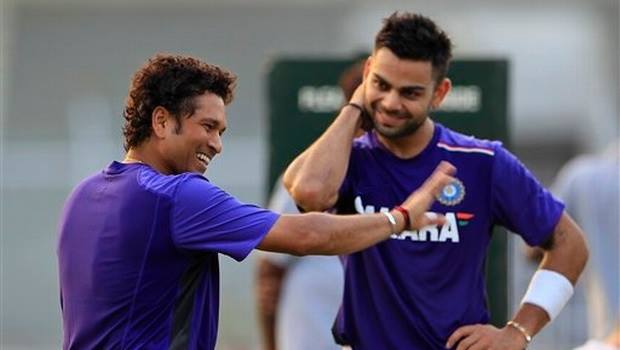Sachin v Kohli - The end to the endless debate on who is the greater of the two

India has a population of 1.25 Billion. 1.5 Billions Indians follow cricket. 2 Billion Indians are talking about Sachin Tendulkar at any point of time. In short not only every Tom, Dick and Harry but also every Laxman, Sivaram and Krishnan has an opinion on Sachin Tendulkar. For a writer, to write about Tendulkar is not just flirting with danger but also courting with disaster. And to do a comparison with another player is nothing short of inviting doom. But we at SportsCafe are a brave lot. So here we go; is Virat Kohli indeed greater than the God? Will that most notorious of bikinis, statistics, provide us a conclusive answer?
Part 1: Tests
Tendulkar has played 200 Test matches, scored 15921 runs and notched up 51 centuries, each a World Record in itself. All this, at a very impressive average of 53.78. In contrast Kohli has played 41 matches so far but his average is considerably lower at 44.02. At the same stage of his career, Tendulkar had an excellent average of 54.92. Going by these numbers alone, there is no comparison between the two. Tendulkar wins hands down.

However, in Tests, away performances carry far greater weight and are a truer indicator of batting greatness. For an Asian batsman, exploits in performances outside of Asia are particularly cherished. Outside Asia, excluding Zimbabwe, Kohli averages a respectable 44.42. However, even here Tendulkar beats him comfortably with an average of over just over 50 in his 1st 41 matches. But the area in which Tendulkar truly scores over Kohli are home performances. After 41 matches Tendulkar averaged a whopping 67.43 compared to a sub-standard 46.04 of Kohli.

If Kohli were to continue his current performance up to 38 years of age, he would end up with 9500 runs and 35 centuries, miles away from Tendulkar’s nearly 16000 runs and 51 centuries. In fact, he would need to play up to the age of 48 years to match Tendulkar’s run tally; not just improbable but impossible.

More ever, Tendulkar played in the 1990’s when there were truly great bowlers and the pitches were more bowling friendly. To illustrate the point, of those who played greater than 20 matches in the 90’s, only 4 players averaged more than 50. Tendulkar led the charts with an average of 58, Steve Waugh comes a distant second with an average of 53 and he didn’t have to face the great Aussie bowlers of his period. In contrast, from 2000 onwards, keeping the same minimum qualification of 20 matches, no less than 23 players have averaged above 50! By common consensus, among his contemporaries, only Lara was comparable to Tendulkar while any of Root, Smith, Williamson and Warner can give Kohli a run for his money.
While these are early days yet, and Kohli might go on to become a truly great Test batsman, it is safe to say that he is unlikely to break Tendulkar’s records.
Part 2: ODI’s
It is in the One Day Internationals that the comparison becomes truly fascinating. As of today, Kohli clearly has the superior numbers. Kohli averages 52 to Tendulkar’s 45 at a superior strike rate. Further, he scores a century once every 7 matches, while Tendulkar needed 9.5 matches. If Kohli were to continue at this rate till the age of 38, he would nearly match Tendulkar’s run tally and actually end up scoring 59 centuries, 10 more than Tendulkar. In fact, at this rate, it will take Kohli only 7 more years to match Tendulkar’s centuries records; scarily, he would only be 35 at that time.

He is already number 4 on the maximum centuries list. It is a mind boggling achievement, 25 centuries in 171 matches; Jayasuriya at number 3 on the list took 445 matches to score 28 centuries while Sangakkara at number 5 has taken 404 matches to score 25 centuries.

But perhaps, it is not an entirely fair comparison. Tendulkar spent his early career batting low down the order, not having the chance to make the maximum impact. It is only when he started to open the innings that he truly came into his own. Similarly for Kohli, number 3 & 4 have been the positions at which he has had the maximum impact. Thus, all our comparisons hereafter will be Tendulkar opening and Kohli at 3 & 4. In these positions, Tendulkar’s average shoots up to 48.29 while Kohli’s increases only marginally to 53.64. Also now Tendulkar scores a century every 7.5 innings. An interesting fact is that Tendulkar is clearly the better batsman when setting targets. He averages 51 to Kohli’s 43. However, Kohli averages a whopping 63 when chasing to Tendulkar’s 46. The difference between the two is glaring. Further, Kohli has scored 15 centuries in just 92 matches when chasing and 13 of these have resulted in victories. His average in won matches while chasing is a Bradman-esque 87.

In fact, Kohli’s average while chasing is the highest among all players who have played more than 25 matches; AB De Villiers is a distant 2nd followed by another legend Michael Bevan. It is almost as if when there is a chase in front of Kohli, an inner compass gets activated and a computer program directs his game. To put it simply, Kohli is the greatest chaser the game has seen thus far.

One area where Kohli has a lot of catching up to do is his performance in knockout matches. Tendulkar has a phenomenal record in knockout matches, averaging 52.25 at a strike rate of 85.48 along with 7 centuries in 53 matches. Kohli, on the other hand, averages less than half of that at 24.4 along with a middling strike rate of 74.39 and no centuries. There is no reason to lose heart though, as he has played only 12 of those matches so far and will have plenty of chances to prove himself in the future. Tendulkar’s average at the same stage of the career, though much better than Kohli, wasn’t exceptional either, with an average of 38.58

Part 3: Peer Comparison
One important fact that is lost in all these numbers is that ODI cricket today is a very different beast than to what it was in 1989, when Tendulkar made his debut more than 27 years ago. The pitches have become flatter, the bats bigger and the boundaries smaller. The scores shot up, the strike rates rocketed and the bowlers became 2nd class citizens. Kohli made his debut in 2008 whereas Tendulkar was at his best in the 90’s when bowlers still dictated terms. Hence, we decided that a true comparison will have to normalize all these variables.
Tendulkar’s career spanned from December of 1989 to March of 2012. During this period, the average of all innings played at No 1 to No 6 position was 32.24 and the strike rate 73.77. Tendulkar averaged 44.83 at a strike rate of 86.23. In One Day cricket, Strike Rate is just as important as averages and hence average is not an adequate parameter for comparison. One solution is to multiply these two numbers and then make the comparison. Using this method Tendulkar’s performance is 1.63 times better than his contemporaries. The corresponding number for Kohli is very similar at 1.68. Hence, using this more nuanced method, it appears that both Tendulkar and Kohli are equally ahead of the pack.

One last comparison that is necessary is the comparison of Tendulkar and Kohli with the other greats of their era. Using the methodology described above, among Tendulkar’s contemporaries only Bevan comes out ahead—40 points to Tendulkar’s 39. However, Tendulkar recorded these numbers over 463 matches to Bevan’s 232 matches. The others including Ponting, Kallis, Anwar and Jayasuriya are far behind. Whereas, in the case of Kohli, AB De Villiers pips him comfortably at 55 points to Kohli’s 47. Amla and Dhoni are just behind at 46.5. This indicates that while Tendulkar was clearly the best ODI batsman of his era, Kohli has stiff competition from AB De Villiers, Dhoni and Amla.

Conclusion:
As far as Tests are concerned, Kohli has miles to go before even being comparable to Tendulkar. However, in ODIs, the comparison between Tendulkar and Kohli is far closer. Currently, Kohli’s career average is far higher than Tendulkar’s and he scores centuries at a much faster rate than Tendulkar. However, when we consider Tendulkar’s numbers merely as an opener with Kohli at 3 & 4, their respective preferred positions, Tendulkar’s numbers improve significantly, though Kohli still comes out better. If we merely consider matches in which India has won, Kohli comes out ahead averaging 70 to Tendulkar’s 60. Tendulkar is better when batting first, while Kohli is miles ahead when chasing. However, in the all-important knockout matches, where there is a perception that Tendulkar struggles, he has an astounding record averaging above 50 and is well ahead of Kohli.
In the peer comparison normalized for different eras, both Kohli and Tendulkar come out equally ahead of their peers. However, while Tendulkar was the undisputed best ODI player of his era, Kohli has AB De Villiers, Amla and Dhoni as worthy competitors. Considering all these factors together, as things stand today, Tendulkar is the better Test batsman while Kohli is the better ODI batsman.
Future is notoriously hard to predict, and this analysis is more an exercise in frivolity rather than any scientific prediction. What is evident though is that Kohli will find it almost impossible to break Tendulkar’s Test records, whereas he has a fair chance of surpassing Tendulkar’s ODI records if he is able to maintain his form and fitness as well as matching Tendulkar’s longevity.
-----------------------------------------------------------------------------------------------------------------------------------------------------------------------------------------------------
And it's now time for you to decide the 'Greatest IPL Player of All-Time'. Cast your vote for your favourite player in the Sportscafe #IPLGOAT poll. And once you are done voting, get your friends as well to vote by sharing the poll with them. For more details on the GOAT poll and to check out the other match-ups and 21 players, check here

Comments
Sign up or log in to your account to leave comments and reactions
0 Comments